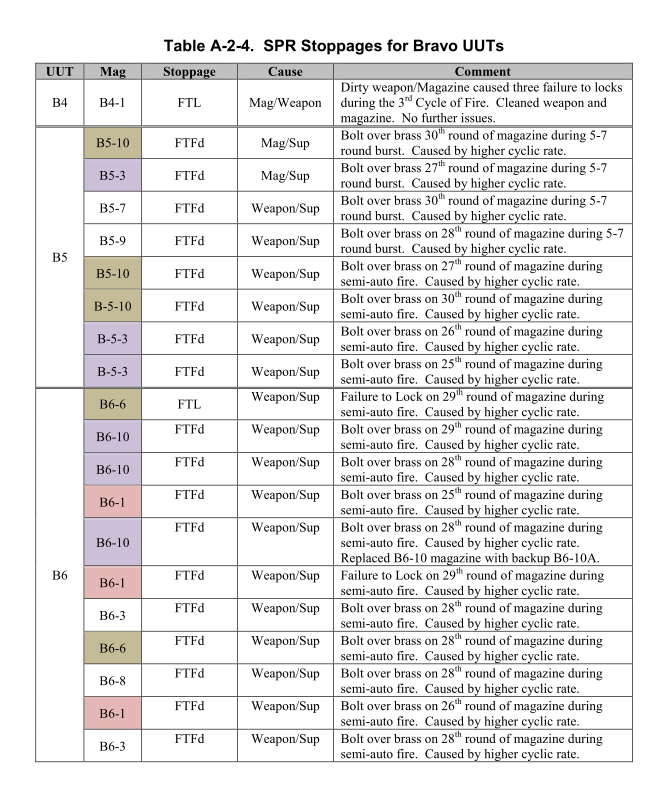On the heels of the USMC’s effort to field 15,000 more Heckler & Koch M27 Infantry Automatic Rifles, as well as the M38 Designated Marksman Rifle variant, The Firearm Blog has received a copy of a 2016 report intended to justify procurement of accessories and additional M27s to fill a need for a special purpose rifle (SPR). The report documents a test conducted at Quantico, Virginia, by the Product Manager, Infantry Weapons Product Management Office (PdM IW). 9 M27 IARs were tested, each firing 2700 rounds over the course of the test. Notably, the Lead Engineer and Assistant Product Manager for this test was the recently-retired Salvatore Fanelli, who worked at Heckler & Koch in the early-mid 2000s.
Despite the document’s overall upbeat tone, it does not present a picture of a system “ready to field”. The optic chosen for the test was the Leupold Mark 4 2.5-8x36mm variable power scope, part number 60150, one mounted to all 9 weapons via a LaRue mount. This particular optic is a strange choice, being a virtual antique by today’s standards (the optics themselves are leftovers from the Mk. 12 SPR program of the early 2000s), and having a mix of mil reticle and MOA adjustments. This latter feature means that an operator cannot make adjustments in the same increments as what is shown on the reticle. For a simple concept validation test this would not be a problem. However the intent, as stated in the document, was to test the:
feasibility and practicality of using the M27 Infantry Automatic Rifle (IAR) as a
Special Purpose Rifle (SPR) to fulfill an Urgent Statement of Need.
[emphasis mine]
Reportedly, the reason for choosing this optic (the 3-9 version of which is slated for use with the M38 which descended from this test) was simply that they existed in inventory at the USMC logistics base in Albany, left over from 2000s-era Mk. 12 SPRs. This raises the question of exactly what logistical pipeline the M38 will depend on for replacements. If the Leupold scope cannot be procured somehow, then the M38 as a system is unsustainable at the start.
The appendices of the document indicate that the rifle system is far from optimally reliable when equipped with the tester-preferred sound suppressor. Guns in the “Bravo” test group, all of which were equipped with that suppressor, experienced bolt over base malfunctions indicating an extremely high cyclic rate and marginal weapon reliability in the suppressed configuration. The test was conducted in winter, when temperatures were low, and used Mk. 262 ammunition, a round well-regarded for its consistency and suitability with 5.56mm weapons. However, USMC forces abroad are now using the M855A1 EPR round, which typically produces much higher cyclic rates than Mk. 262. Despite the obvious cyclic rate issues when suppressed, the equipment used to measure cyclic rate reportedly malfunctioned, and no further mention of cyclic rate issues was made until the appendix.
Coupled with that, point of impact shifts of up to 5 MOA between the suppressed and unsuppressed configurations raise the question of whether the weapon is suitable for suppression at all: Cyclic rate and reliability are marginal at best when suppressed with the Bravo group unit, precluding an “always suppressed” doctrine to fix the POI shift issues. At the same time, the test manager concludes that “POI shift is not as important as it once was”, an unusual statement when concerning a system that is intended for precision use against point targets while either suppressed or unsuppressed.
In brief, the weapon system demonstrated in this test does not seem to be suitable for issue in that configuration. Unfortunately, the M27 and M38 platforms as they currently stand are fixed specification items. Engineering change proposals (ECPs) to the weapon itself and/or the suppressor would be necessary to make the system as a whole suitable for use in this role. This presents an issue for the M38 DMR program, as the original intent was to use off-the-shelf components along with the in-inventory M27 rifle to produce a designated marksman’s rifle or special purpose rifle to fill an urgent USMC need. ECPs or new suppressor designs potentially change the M38 program from a non-developmental effort, into a new developmental program which could potentially deviate the M38 specification away from the current issue M27.
There is another layer to uncover here, as well. Looking through the 4 November 2016 Infantry Training & Readiness Manual, we see something a little odd:
Pictured: Oddly specific.
The Infantry Training & Readiness manual lists the M27 (not M38) “Designated Marksman rifle”, as well as the “Leopold (sic) Mark IV 3X-9X scope”. No other T&R listing is this specific, and no other lists a manufacturer, as that would imply weapons must be procured from that vendor. This raises the question of whether a change to the T&R Manual was made in an attempt to “backdoor” the M27 with the Mark 4 scope as a designated marksman rifle system, eventually leading to the M38. To say this would be out of the ordinary is an understatement; it’s virtually the opposite of how the process is intended to work.
Disclosure: I am now an employee of Knight’s Enterprises, LLC. Any statements made in this or any other article are my own and not promoted by or associated with Knight’s Enterprises, Knight’s Armament, or any affiliate company. Despite my relationship with Knight’s, I try to maintain an objective perspective on small arms development. However, it is impossible to eliminate bias completely, therefore any analysis made in this article should be taken with that fact in mind.
 Your Privacy Choices
Your Privacy Choices






